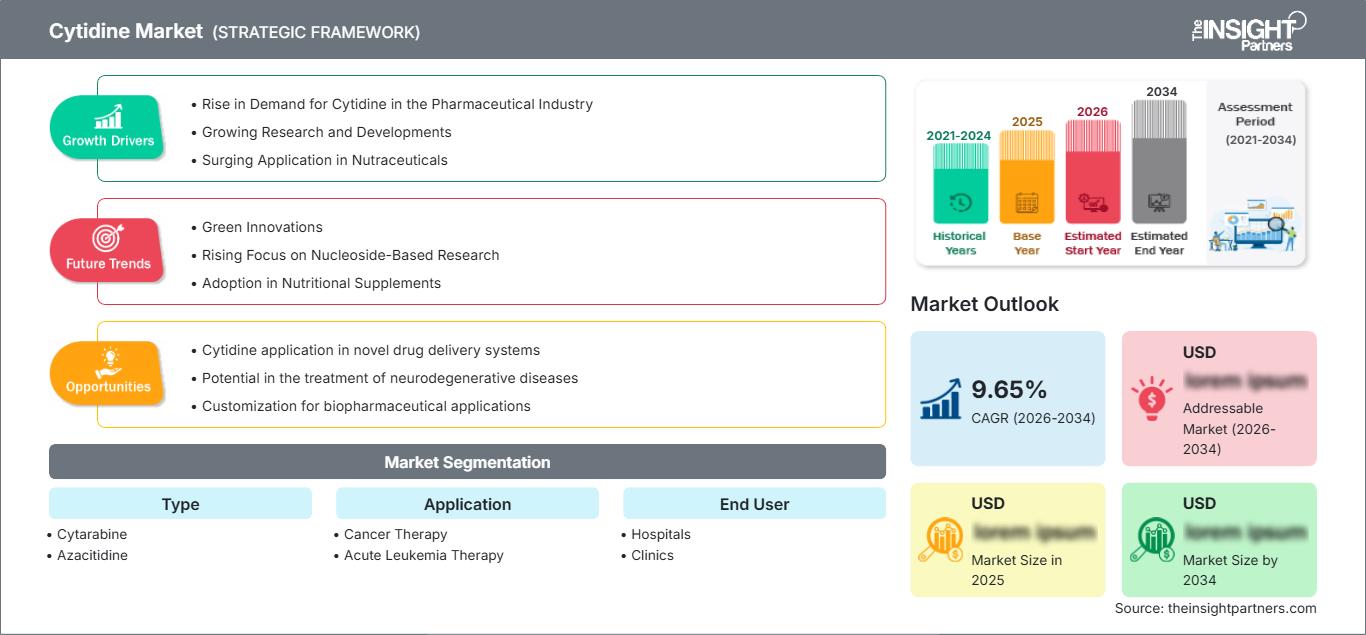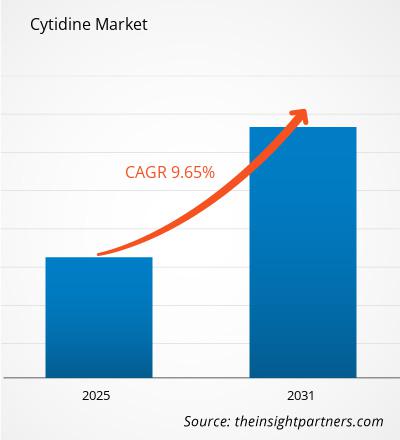Se prevé que el mercado de la citidina crezca a una tasa anual compuesta del 9,65% entre 2026 y 2034. Las condiciones del mercado siguen evolucionando, lo que abre nuevas oportunidades para los interesados. El panorama general refleja un progreso estable y un potencial de crecimiento a largo plazo.
El informe de investigación se clasifica por tipo en los siguientes subsegmentos: Citidina Natural y Citidina Sintética. Además, presenta un análisis basado en la aplicación, incluyendo Farmacéuticas, Investigación y Desarrollo, y otros. Además, el informe evalúa a los usuarios finales, como compañías farmacéuticas, empresas biotecnológicas e instituciones de investigación. El análisis global se desglosa a nivel regional y a los principales países, cubriendo regiones clave como Norteamérica, Europa, Asia Pacífico, Oriente Medio y África, y Sudamérica. La evaluación del mercado se presenta en dólares estadounidenses para el análisis segmental anterior.
Propósito del informe
El informe Mercado de la Citidina de The Insight Partners pretende describir el panorama actual y el crecimiento futuro, los principales factores impulsores, los desafíos y las oportunidades. Esto proporcionará información a diversos actores empresariales, como:
- Proveedores de tecnología/fabricantes: Para comprender la dinámica cambiante del mercado y conocer las posibles oportunidades de crecimiento, permitiéndoles tomar decisiones estratégicas informadas.
- Inversores: Realizar un análisis exhaustivo de tendencias sobre la tasa de crecimiento del mercado, las proyecciones financieras y las oportunidades que existen a lo largo de la cadena de valor.
- Organismos reguladores: Regular las políticas y vigilar las actividades en el mercado con el objetivo de minimizar el abuso, preservar la confianza y la confianza de los inversores, y mantener la integridad y estabilidad del mercado.
Segmentación del mercado de citidina
- Tipo de segmentación CitarabinaAplicación
- de azacididina
- Terapia contra el cáncer
- Terapia de leucemia aguda
Hospitales de usuario final
- Clínicas
Disfrutará de la personalización gratuita de cualquier informe, incluyendo partes del mismo, análisis por país y un paquete de datos de Excel. Además, podrá aprovechar excelentes ofertas y descuentos para startups y universidades.
Mercado de citidina: Perspectivas estratégicas

-
Obtenga las principales tendencias clave del mercado de este informe.Esta muestra GRATUITA incluye análisis de datos, desde tendencias del mercado hasta estimaciones y pronósticos.
Impulsores del crecimiento del mercado de la citidina
- Aumento de la demanda de citidina en la industria farmacéutica: La citidina actúa como elemento de construcción para crear medicamentos análogos de nucleósidos que tratan el cáncer, además de enfermedades virales y neurológicas. El aumento de casos de estas enfermedades impulsa la demanda de citidina para la elaboración de diferentes tipos de productos farmacéuticos. Los procesos metabólicos y de producción naturales del ARN lo hacen esencial para la investigación médica y el desarrollo terapéutico.
- Crecimiento de la investigación y el desarrollo: Las actividades de investigación en biotecnología y biología molecular impulsan la demanda de citidina para proyectos de descubrimiento médico y genético. El uso de citidina aumenta porque ayuda a crear ARN, lo que conduce a avances en la investigación genómica y la medicina personalizada, impulsando así la demanda del mercado.
- Aumento de la aplicación en nutracéuticos: La citidina se utiliza actualmente para desarrollar suplementos dietéticos y productos que protegen el cerebro. Las investigaciones demuestran que la citidina ofrece beneficios para una mejor memoria y favorece la función cerebral, además de ser prometedora en el tratamiento de la enfermedad de Alzheimer. Las personas ahora usan más citidina en suplementos dietéticos y alimentos funcionales porque buscan una mejor salud cerebral y rendimiento mental.
Tendencias futuras del mercado de citidina
- Innovaciones ecológicas: Los consumidores de productos dentales ahora se componen de un gran grupo de pacientes de la generación del baby boom. Las innovaciones ecológicas incluyen cambios tanto en las unidades operativas dentales como en la producción de las mismas para reducir el impacto ambiental, además de la adición de componentes electrónicos para satisfacer las necesidades de los sistemas computarizados.
- Creciente enfoque en la investigación basada en nucleósidos: Las herramientas biotecnológicas modernas ayudan a los científicos a estudiar los nucleósidos de citidina con mayor profundidad. Los científicos usan citidina para estudiar las funciones del ARN mientras realizan modificaciones genéticas y crean nuevos tipos de ARN. Las actividades de investigación y desarrollo requieren más citidina debido al aumento del desarrollo terapéutico basado en ARN, incluyendo vacunas de ARNm y herramientas de interferencia de ARN.
- Adopción en suplementos nutricionales: Las empresas de suplementos usan citidina con mayor frecuencia para desarrollar productos que ayudan a las personas a pensar mejor y protegen su salud cerebral. Las personas toman suplementos de citicolina para mejorar su memoria y concentración, especialmente en la tercera edad. La gente está comprando más productos de salud y bienestar, lo que impulsa el crecimiento de los suplementos de citidina en el mundo empresarial.
Oportunidades de mercado para la citidina
- Aplicación de la citidina en nuevos sistemas de administración de fármacos: La tecnología avanzada de administración de fármacos ayuda a la citidina a funcionar mejor a través de nanotransportadores y liposomas. Los sistemas avanzados de administración de fármacos ayudan a que los tratamientos basados en citidina funcionen mejor en terapias dirigidas al mejorar la absorción y el rendimiento del fármaco. El nuevo avance en el uso de la citidina debería recibir más financiación para desarrollar su investigación y aplicaciones médicas.
- Potencial en el tratamiento de enfermedades neurodegenerativas: Los mercados para el tratamiento de enfermedades neurodegenerativas ofrecen un fuerte potencial de crecimiento para la citidina, ya que ayuda a mantener la salud cerebral y a reparar las células dañadas. Los investigadores continúan estudiando cómo la citidina protege el cerebro y mejora las habilidades de pensamiento, lo que la convierte en una candidata prometedora para tratamientos médicos. Personalización para aplicaciones biofarmacéuticas: Las empresas biofarmacéuticas buscan ofrecer soluciones únicas que se adapten a sus diversas operaciones de investigación y fabricación. El sector de la producción requiere la creación de productos de citidina personalizados para ayudar a los investigadores que trabajan con la síntesis de ARNm y técnicas de ingeniería genética.
Mercado de citidina
Los analistas de The Insight Partners han explicado detalladamente las tendencias regionales y los factores que influyen en el mercado de citidina durante el período de pronóstico. Esta sección también analiza los segmentos del mercado de gestión de enfermedades del ritmo cardíaco y la geografía en América del Norte, Europa, Asia Pacífico, Oriente Medio y África, y América del Sur y Central.
Alcance del informe de mercado de citidina
By Aplicación- Terapia contra el cáncer
- Terapia contra la leucemia aguda
- hospitales
- clínicas
- Reino Unido
- Alemania
- Francia
- Rusia
- Italia
- Resto de Europa
- China
- India
- Japón
- Australia
- Resto de Asia-Pacífico
- Brasil
- Argentina
- Resto de América del Sur y Central
- Sudáfrica
- Arabia Saudita
- Emiratos Árabes Unidos
- Resto de Oriente Medio y África
Atributo del informe Detalles Tamaño del mercado en 2025 US$ XX Million Tamaño del mercado por 2034 US$ XX Million CAGR global (2026 - 2034) 9.65% Datos históricos 2021-2024 Período de pronóstico 2026-2034 Segmentos cubiertos By Tipo - Citarabina
- Azacitidina
Regiones y países cubiertos Norteamérica - EE. UU.
- Canadá
- México
Líderes del mercado y perfiles de empresas clave - HBio (Hellenic Bio Cluster)
- Pfizer Inc.
- Amgen Inc.
- F. Hoffmann-La Roche Ltd
- BIOGEN IDEC INC.
- Cipla
- AstraZeneca
- Teva Pharmaceutical Industries Ltd.
- Sigma-Aldrich, Inc.
Densidad de actores del mercado de citidina: comprensión de su impacto en la dinámica empresarial
El mercado de la citidina está creciendo rápidamente, impulsado por la creciente demanda del usuario final debido a factores como la evolución de las preferencias de los consumidores, los avances tecnológicos y un mayor conocimiento de los beneficios del producto. A medida que aumenta la demanda, las empresas amplían su oferta, innovan para satisfacer las necesidades de los consumidores y aprovechan las tendencias emergentes, lo que impulsa aún más el crecimiento del mercado.

- Conseguir el Mercado de citidina Resumen de las principales jugadoras clave
Puntos Clave de Venta
- Cobertura Integral: El informe abarca el análisis exhaustivo de productos, servicios, tipos y usuarios finales del mercado de citidina, ofreciendo un panorama holístico.
- Análisis de Expertos: El informe se elabora con base en el profundo conocimiento de expertos y analistas de la industria.
- Información Actualizada: El informe garantiza relevancia comercial gracias a su cobertura de información y tendencias de datos recientes.
- Opciones de Personalización: Este informe se puede personalizar para satisfacer las necesidades específicas del cliente y adaptarse a las estrategias comerciales.
Por lo tanto, el informe de investigación sobre el mercado de citidina puede ayudar a liderar el camino para decodificar y comprender el escenario de la industria y las perspectivas de crecimiento. Si bien puede haber algunas preocupaciones válidas, las ventajas generales de este informe tienden a superar las desventajas.
- Análisis histórico (2 años), año base, pronóstico (7 años) con CAGR
- Análisis PEST y FODA
- Tamaño del mercado, valor/volumen: global, regional y nacional
- Industria y panorama competitivo
- Conjunto de datos de Excel
Informes recientes
Testimonios
Razón para comprar
- Toma de decisiones informada
- Comprensión de la dinámica del mercado
- Análisis competitivo
- Información sobre clientes
- Pronósticos del mercado
- Mitigación de riesgos
- Planificación estratégica
- Justificación de la inversión
- Identificación de mercados emergentes
- Mejora de las estrategias de marketing
- Impulso de la eficiencia operativa
- Alineación con las tendencias regulatorias






















 Obtenga una muestra gratuita para - Mercado de citidina
Obtenga una muestra gratuita para - Mercado de citidina